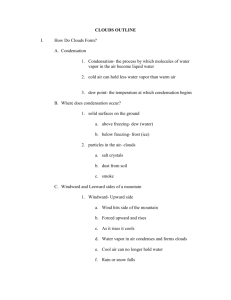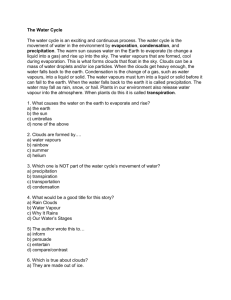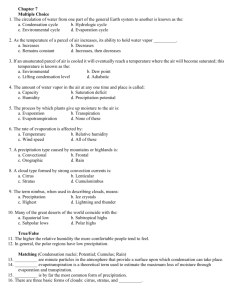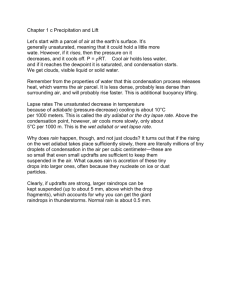Chapter 18 Reading Guide
advertisement
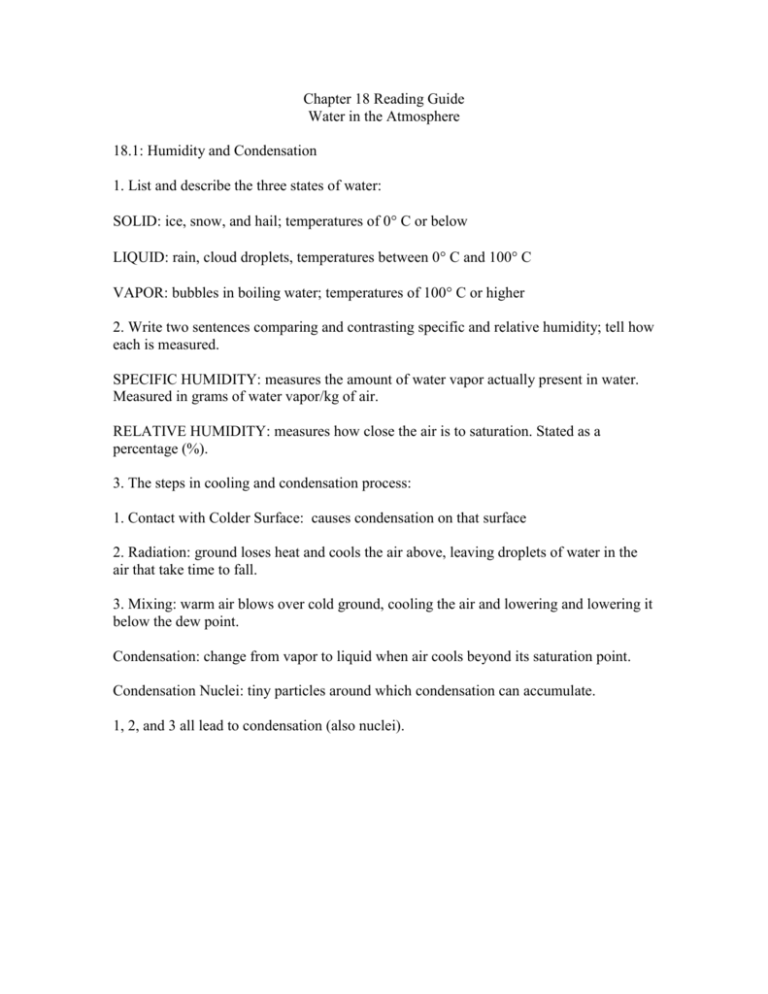
Chapter 18 Reading Guide Water in the Atmosphere 18.1: Humidity and Condensation 1. List and describe the three states of water: SOLID: ice, snow, and hail; temperatures of 0 C or below LIQUID: rain, cloud droplets, temperatures between 0 C and 100 C VAPOR: bubbles in boiling water; temperatures of 100 C or higher 2. Write two sentences comparing and contrasting specific and relative humidity; tell how each is measured. SPECIFIC HUMIDITY: measures the amount of water vapor actually present in water. Measured in grams of water vapor/kg of air. RELATIVE HUMIDITY: measures how close the air is to saturation. Stated as a percentage (%). 3. The steps in cooling and condensation process: 1. Contact with Colder Surface: causes condensation on that surface 2. Radiation: ground loses heat and cools the air above, leaving droplets of water in the air that take time to fall. 3. Mixing: warm air blows over cold ground, cooling the air and lowering and lowering it below the dew point. Condensation: change from vapor to liquid when air cools beyond its saturation point. Condensation Nuclei: tiny particles around which condensation can accumulate. 1, 2, and 3 all lead to condensation (also nuclei). 18.2: Clouds Complete the organizer with the information about the different types of clouds. Tell whether each forms vertically or horizontally and at what altitude each is found. Describe appearance and weather impact when possible. Cirrostratus Cirrocumulus High altitude; horizontal; thin sheets that High altitude; vertical; puffy clouds may suggest precipitation especially in the winter Altostratus Altocumulus Middle altitude; horizontal; similar to Middle altitude; vertical; similar to cirrostratus cirrocumulus Nimbostratus Stratocumulus Low altitude; horizontal; dark gray layers Low altitude; horizontal and vertical of clouds that produce steady rain Cumulonimbus/Cumulus Can span many altitudes; vertical; cumulonimbus produce heavy rain with thunder and lightning. Tell how one cloud type from the above organizer forms: Altostratus clouds form as air rises and cools in layers. These layers form when the surrounding air is stable and forces rising air to move horizontally rather than vertically. Cumulonimbus clouds begin forming when moist air rises and cools to its dew point. Cumulus clouds form as air in a growing cumulus cloud moves upward because it is buoyant and its temperature is warmer than that of the surrounding air. Stratus clouds form in stable air. In stable air, air cannot easily move up or down, so it tends to spread out horizontally in layers. 18.3: Precipitation Complete the chart by describing the formation of each precipitation type. Include information about temperature. 1. Rain 2. Sleet 3. Freezing Rain 4. Hail 5. Snow Water droplets that have become big enough to fall to the ground Forms when rain falls into a layer of cold air Forms when raindrops freeze instantly when they hit a solid surface Forms when a frozen raindrop or clump of ice crystals is blown back up repeatedly, building up layers of ice before falling to the ground Forms when ice crystals in a cloud collide and clump together List and explain the factors that contribute to frequent precipitation in some areas and dryness in other areas. Precipitation forms in areas where air rises and produces condensation. These areas include places near the equator where the sun’s heat raises land and air temperatures, places with low pressure where storms are common, and places where moist air rises over mountains and cools. Dryness occurs in places where air sinks and warms. These places include areas of persistent high pressure, areas with extremely cold temperatures, and areas on the leeward side of mountains where dry air sinks.


